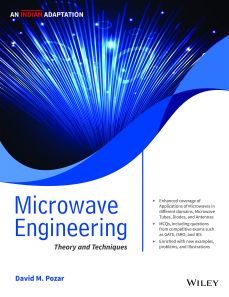Microwave Engineering: Theory and Techniques, 4ed, An Indian Adaptation
ISBN: 9789388991087
658 pages
For more information write to us at: acadmktg@wiley.com

Description
Microwave Engineering: Theory and Techniques is a self-sustaining literature for an undergraduate as
well as a graduate program on the principles of microwave engineering. The book provides a comprehensive discourse of the fundamentals of the subject and design principles as applied to modern RF and microwave engineering. Starting with the fundamental principles of electromagnetic theory, the book goes on to cover microwave network analysis, impedance matching, directional couplers and hybrids, microwave filters, ferrite devices, noise, nonlinear effects, and the design of microwave oscillators, amplifiers, and mixers. Material on microwave and RF systems includes wireless communication, radar, radiometry, and radiation hazards.
Chapter 1 REVIEW OF ELECTROMAGNETIC THEORY
1.1 Introduction to Microwave Engineering
1.2 Maxwell’s Equations
1.3 Fields in Media and Boundary Conditions
1.4 The Wave Equation and Basic Plane Wave Solutions
1.5 General Plane Wave Solutions
1.6 Energy and Power
1.7 Plane Wave Reflection from a Media Interface
1.8 Oblique Incidence at a Dielectric Interface
1.9 Some Useful Theorems
Chapter 2 TRANSMISSION LINE THEORY
2.1 The Lumped-Element Circuit Model for a Transmission Line
2.2 Field Analysis of Transmission Lines
2.3 The Terminated Lossless Transmission Line
2.4 The Smith Chart
2.5 Generator and Load Mismatches
2.6 Lossy Transmission Lines
2.7 Transients on Transmission Lines
Chapter 3 TRANSMISSION LINES AND WAVEGUIDES
3.1 General Solutions for TEM, TE, and TM Waves
3.2 Parallel Plate Waveguide
3.3 Rectangular Waveguide
3.4 Circular Waveguide
3.5 Coaxial Line
3.6 Surface Waves on a Grounded Dielectric Sheet
3.7 Stripline
3.8 Microstrip Line
3.9 The Transverse Resonance Technique
3.10 Wave Velocities and Dispersion
3.11 Summary of Transmission Lines and Waveguides
Chapter 4 MICROWAVE NETWORK ANALYSIS
4.1 Impedance and Equivalent Voltages and Currents
4.2 Impedance and Admittance Matrices
4.3 The Scattering Matrix
4.4 The Transmission (ABCD) Matrix
4.5 Signal Flow Graphs
4.6 Discontinuities and Modal Analysis
4.7 Excitation of Waveguides—Electric and Magnetic Currents
Chapter 5 IMPEDANCE MATCHING AND TUNING
5.1 Matching with Lumped Elements (L Networks)
5.2 Single-Stub Tuning
5.3 Double-Stub Tuning
5.4 The Quarter-Wave Transformer
5.5 The Theory of Small Reflections
5.6 Binomial Multisection Matching Transformers
5.7 Chebyshev Multisection Matching Transformers
5.8 Tapered Lines
Chapter 6 MICROWAVE RESONATORS
6.1 Series and Parallel Resonant Circuits
6.2 Transmission Line Resonators
6.3 Rectangular Waveguide Cavity Resonators
6.4 Circular Waveguide Cavity Resonators
6.5 Dielectric Resonators
6.6 Excitation of Resonators
Chapter 7 POWER DIVIDERS AND DIRECTIONAL COUPLERS
7.1 Basic Properties of Dividers and Couplers
7.2 The T-Junction Power Divider
7.3 The Wilkinson Power Divider
7.4 Waveguide Directional Couplers
7.5 The Quadrature (90◦) Hybrid
7.6 Coupled Line Directional Couplers
7.7 The Lange Coupler
7.8 The 180◦ Hybrid
7.9 Other Couplers
Chapter 8 MICROWAVE FILTERS
8.1 Periodic Structures
8.2 Filter Design by the Image Parameter Method
8.3 Filter Design by the Insertion Loss Method
8.4 Filter Transformations
8.5 Filter Implementation
8.6 Stepped-Impedance Low-Pass Filters
8.7 Coupled Line Filters
Chapter 9 THEORY AND DESIGN OF FERRIMAGNETIC COMPONENTS
9.1 Basic Properties of Ferrimagnetic Materials
9.2 Plane Wave Propagation in a Ferrite Medium
9.3 Propagation in a Ferrite-Loaded Rectangular Waveguide
9.4 Ferrite Isolators
9.5 Ferrite Phase Shifters
9.6 Ferrite Circulators
Chapter 10 NOISE AND NONLINEAR DISTORTION
10.1 Noise in Microwave Circuits
10.2 Noise Figure
10.3 Nonlinear Distortion
10.4 Precipitation Titrations
Chapter 11 ACTIVE RF AND MICROWAVE DEVICES
11.1 Diodes and Diode Circuits
11.2 Bipolar Junction Transistors
11.3 Field Effect Transistors
11.4 Microwave Integrated Circuits
11.5 Microwave Tubes
Chapter 12 MICROWAVE AMPLIFIER DESIGN
12.1 Two-Port Power Gains
12.2 Stability
12.3 Single-Stage Transistor Amplifier Design
12.4 Broadband Transistor Amplifier Design
12.5 Power Amplifiers
Chapter 13 OSCILLATORS AND MIXERS
13.1 RF Oscillators
13.2 Microwave Oscillators
13.3 Oscillator Phase Noise
13.4 Frequency Multipliers
13.5 Mixers
Chapter 14 INTRODUCTION TO MICROWAVE SYSTEMS
14.1 System Aspects of Antennas
14.2 Wireless Communication
14.3 Radar Systems
14.4 Radiometer Systems
14.5 Microwave Propagation
14.6 Other Applications and Topics
References
Problems
Multiple Choice Questions
Appendices
Appendix A Prefixes
Appendix B Vector Analysis
Appendix C Bessel Functions
Appendix D Useful Results
Appendix E Other Mathematical Results
Appendix F Physical Constants
Appendix G Conductivities for Some Materials
Appendix H Dielectric Constants and Loss Tangents for Some Materials
Appendix I Properties of Some Microwave Ferrite Materials
Appendix J Standard Rectangular Waveguide Data
Appendix K Standard Coaxial Cable Data
ANSWERS TO SELECTED
PROBLEMS

